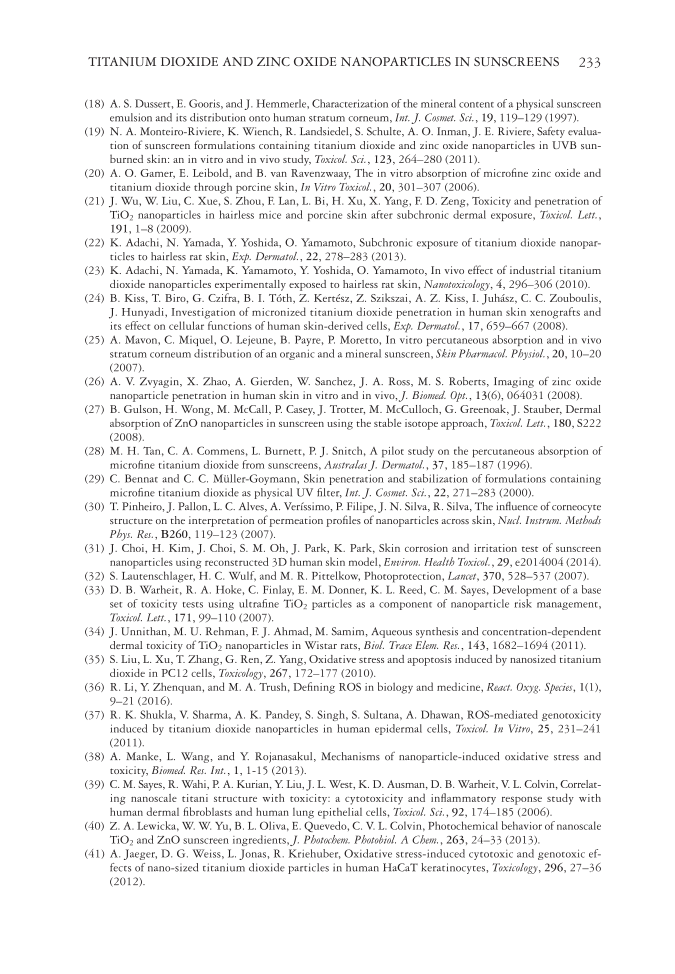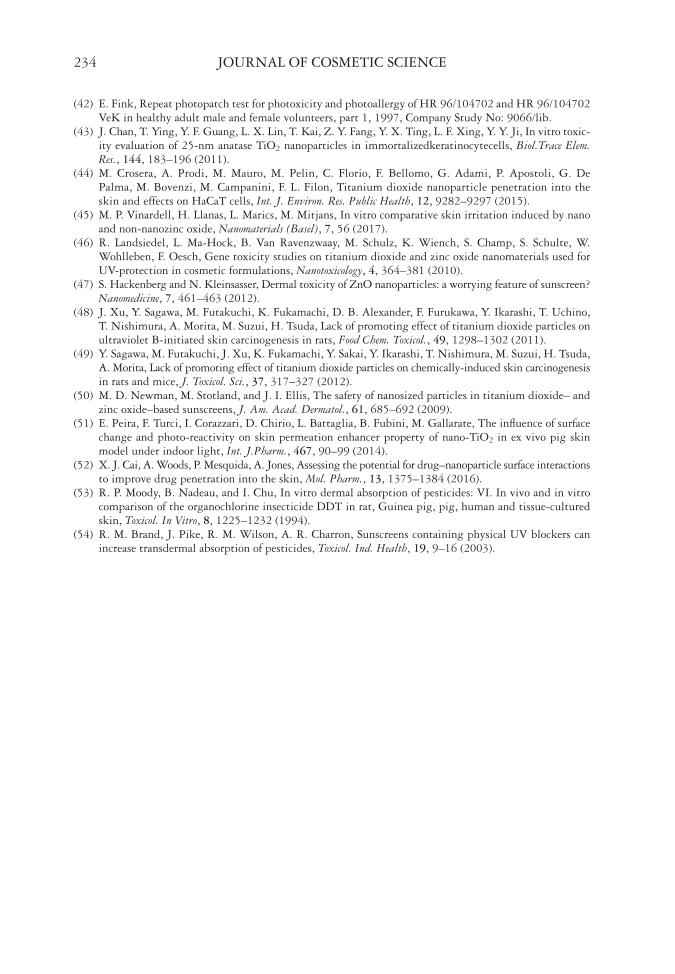TITANIUM DIOXIDE AND ZINC OXIDE NANOPARTICLES IN SUNSCREENS 233 ( 1 8) A. S. Dussert, E. Gooris, and J. Hemmerle, Characterization of the mineral content of a physical sunscreen emulsion and its distribution onto human stratum corneum, Int. J. Cosmet. Sci., 19, 119–129 (1997). ( 1 9) N. A. Monteiro-Riviere, K. Wiench, R. Landsiedel, S. Schulte, A. O. Inman, J. E. Riviere, Safety evalua- tion of sunscreen formulations containing titanium dioxide and zinc oxide nanoparticles in UVB sun- burned skin: an in vitro and in vivo study, Toxicol. Sci., 123, 264–280 (2011). (2 0) A. O. Gamer, E. Leibold, and B. van Ravenzwaay, The in vitro absorption of microfi ne zinc oxide and titanium dioxide through porcine skin, In Vitro Toxicol., 20, 301–307 (2006). ( 2 1) J. Wu, W. Liu, C. Xue, S. Zhou, F. Lan, L. Bi, H. Xu, X. Yang, F. D. Zeng, Toxicity and penetration of TiO2 nanoparticles in hairless mice and porcine skin after subchronic dermal exposure, Toxicol. Lett., 191, 1–8 (2009). ( 2 2) K. Adachi, N. Yamada, Y. Yoshida, O. Yamamoto, Subchronic exposure of titanium dioxide nanopar- ticles to hairless rat skin, Exp. Dermatol., 22, 278–283 (2013). ( 2 3) K. Adachi, N. Yamada, K. Yamamoto, Y. Yoshida, O. Yamamoto, In vivo effect of industrial titanium dioxide nanoparticles experimentally exposed to hairless rat skin, Nanotoxicology, 4, 296–306 (2010). (2 4) B. Kiss, T. Biro, G. Czifra, B. I. Tóth, Z. Kertész, Z. Szikszai, A. Z. Kiss, I. Juhász, C. C. Zouboulis, J. Hunyadi, Investigation of micronized titanium dioxide penetration in human skin xenografts and its effect on cellular functions of human skin-derived cells, Exp. Dermatol., 17, 659–667 (2008). ( 2 5) A. Mavon, C. Miquel, O. Lejeune, B. Payre, P. Moretto, In vitro percutaneous absorption and in vivo stratum corneum distribution of an organic and a mineral sunscreen, Skin Pharmacol. Physiol., 20, 10–20 (2007). ( 2 6) A. V. Zvyagin, X. Zhao, A. Gierden, W. Sanchez, J. A. Ross, M. S. Roberts, Imaging of zinc oxide nanoparticle penetration in human skin in vitro and in vivo, J. Biomed. Opt., 13(6), 064031 (2008). (2 7) B. Gulson, H. Wong, M. McCall, P. Casey, J. Trotter, M. McCulloch, G. Greenoak, J. Stauber, Dermal absorption of ZnO nanoparticles in sunscreen using the stable isotope approach, Toxicol. Lett., 180, S222 (2008). (2 8) M. H. Tan, C. A. Commens, L. Burnett, P. J. Snitch, A pilot study on the percutaneous absorption of microfi ne titanium dioxide from sunscreens, Australas J. Dermatol., 37, 185–187 (1996). ( 2 9) C. Bennat and C. C. Müller-Goymann, Skin penetration and stabilization of formulations containing microfi ne titanium dioxide as physical UV fi lter, Int. J. Cosmet. Sci., 22, 271–283 (2000). (3 0 ) T. Pinheiro, J. Pallon, L. C. Alves, A. Veríssimo, P. Filipe, J. N. Silva, R. Silva, The infl uence of corneocyte structure on the interpretation of permeation profi les of nanoparticles across skin, Nucl. Instrum. Methods Phys. Res., B260, 119–123 (2007). (3 1 ) J. Choi, H. Kim, J. Choi, S. M. Oh, J. Park, K. Park, Skin corrosion and irritation test of sunscreen nanoparticles using reconstructed 3D human skin model, Environ. Health Toxicol., 29, e2014004 (2014). (32 ) S. Lautenschlager, H. C. Wulf, and M. R. Pittelkow, Photoprotection, Lancet, 370, 528–537 (2007). (3 3 ) D. B. Warheit, R. A. Hoke, C. Finlay, E. M. Donner, K. L. Reed, C. M. Sayes, Development of a base set of toxicity tests using ultrafi ne TiO2 particles as a component of nanoparticle risk management, Toxicol. Lett., 171, 99–110 (2007). (3 4 ) J. Unnithan, M. U. Rehman, F. J. Ahmad, M. Samim, Aqueous synthesis and concentration-dependent dermal toxicity of TiO2 nanoparticles in Wistar rats, Biol. Trace Elem. Res., 143, 1682–1694 (2011). (3 5 ) S. Liu, L. Xu, T. Zhang, G. Ren, Z. Yang, Oxidative stress and apoptosis induced by nanosized titanium dioxide in PC12 cells, Toxicology, 267, 172–177 (2010). (36 ) R. Li, Y. Zhenquan, and M. A. Trush, Defi ning ROS in biology and medicine, React. Oxyg. Species, 1(1), 9–21 (2016). (3 7 ) R. K. Shukla, V. Sharma, A. K. Pandey, S. Singh, S. Sultana, A. Dhawan, ROS-mediated genotoxicity induced by titanium dioxide nanoparticles in human epidermal cells, Toxicol. In Vitro, 25, 231–241 (2011). ( 38 ) A. Manke, L. Wang, and Y. Rojanasakul, Mechanisms of nanoparticle-induced oxidative stress and toxicity, Biomed. Res. Int., 1, 1-15 (2013). ( 39 ) C. M. Sayes, R. Wahi, P. A. Kurian, Y. Liu, J. L. West, K. D. Ausman, D. B. Warheit, V. L. Colvin, Correlat- ing nanoscale titani structure with toxicity: a cytotoxicity and infl ammatory response study with human dermal fi broblasts and human lung epithelial cells, Toxicol. Sci., 92, 174–185 (2006). (4 0 ) Z. A. Lewicka, W. W. Yu, B. L. Oliva, E. Quevedo, C. V. L. Colvin, Photochemical behavior of nanoscale TiO2 and ZnO sunscreen ingredients, J. Photochem. Photobiol. A Chem., 263, 24–33 (2013). (4 1 ) A. Jaeger, D. G. Weiss, L. Jonas, R. Kriehuber, Oxidative stress-induced cytotoxic and genotoxic ef- fects of nano-sized titanium dioxide particles in human HaCaT keratinocytes, Toxicology, 296, 27–36 (2012).
JOURNAL OF COSMETIC SCIENCE 234 (42 ) E. Fink, Repeat photopatch test for photoxicity and photoallergy of HR 96/104702 and HR 96/104702 VeK in healthy adult male and female volunteers, part 1, 1997, Company Study No: 9066/lib. (4 3 ) J. Chan, T. Ying, Y. F. Guang, L. X. Lin, T. Kai, Z. Y. Fang, Y. X. Ting, L. F. Xing, Y. Y. Ji, In vitro toxic- ity evaluation of 25-nm anatase TiO2 nanoparticles in immortalizedkeratinocytecells, Biol.Trace Elem. Res., 144, 183–196 (2011). (4 4 ) M. Crosera, A. Prodi, M. Mauro, M. Pelin, C. Florio, F. Bellomo, G. Adami, P. Apostoli, G. De Palma, M. Bovenzi, M. Campanini, F. L. Filon, Titanium dioxide nanoparticle penetration into the skin and effects on HaCaT cells, Int. J. Environ. Res. Public Health, 12, 9282–9297 (2015). ( 45 ) M. P. Vinardell, H. Llanas, L. Marics, M. Mitjans, In vitro comparative skin irritation induced by nano and non-nanozinc oxide, Nanomaterials (Basel), 7, 56 (2017). (4 6 ) R. Landsiedel, L. Ma-Hock, B. Van Ravenzwaay, M. Schulz, K. Wiench, S. Champ, S. Schulte, W. Wohlleben, F. Oesch, Gene toxicity studies on titanium dioxide and zinc oxide nanomaterials used for UV-protection in cosmetic formulations, Nanotoxicology, 4, 364–381 (2010). ( 47 ) S. Hackenberg and N. Kleinsasser, Dermal toxicity of ZnO nanoparticles: a worrying feature of sunscreen? Nanomedicine, 7, 461–463 (2012). (48 ) J. Xu, Y. Sagawa, M. Futakuchi, K. Fukamachi, D. B. Alexander, F. Furukawa, Y. Ikarashi, T. Uchino, T. Nishimura, A. Morita, M. Suzui, H. Tsuda, Lack of promoting effect of titanium dioxide particles on ultraviolet B-initiated skin carcinogenesis in rats, Food Chem. Toxicol., 49, 1298–1302 (2011). (4 9 ) Y. Sagawa, M. Futakuchi, J. Xu, K. Fukamachi, Y. Sakai, Y. Ikarashi, T. Nishimura, M. Suzui, H. Tsuda, A. Morita, Lack of promoting effect of titanium dioxide particles on chemically-induced skin carcinogenesis in rats and mice, J. Toxicol. Sci., 37, 317–327 (2012). (5 0 ) M. D. Newman, M. Stotland, and J. I. Ellis, The safety of nanosized particles in titanium dioxide– and zinc oxide–based sunscreens, J. Am. Acad. Dermatol., 61, 685–692 (2009). (5 1 ) E. Peira, F. Turci, I. Corazzari, D. Chirio, L. Battaglia, B. Fubini, M. Gallarate, The infl uence of surface change and photo-reactivity on skin permeation enhancer property of nano-TiO2 in ex vivo pig skin model under indoor light, Int. J.Pharm., 467, 90–99 (2014). (5 2 ) X. J. Cai, A. Woods, P. Mesquida, A. Jones, Assessing the potential for drug–nanoparticle surface interactions to improve drug penetration into the skin, Mol. Pharm., 13, 1375–1384 (2016). (5 3 ) R. P. Moody, B. Nadeau, and I. Chu, In vitro dermal absorption of pesticides: VI. In vivo and in vitro comparison of the organochlorine insecticide DDT in rat, Guinea pig, pig, human and tissue-cultured skin, Toxicol. In Vitro, 8, 1225–1232 (1994). (5 4 ) R. M. Brand, J. Pike, R. M. Wilson, A. R. Charron, Sunscreens containing physical UV blockers can increase transdermal absorption of pesticides, Toxicol. Ind. Health, 19, 9–16 (2003).
Purchased for the exclusive use of nofirst nolast (unknown) From: SCC Media Library & Resource Center (library.scconline.org)


















































